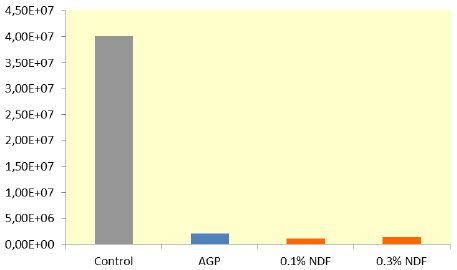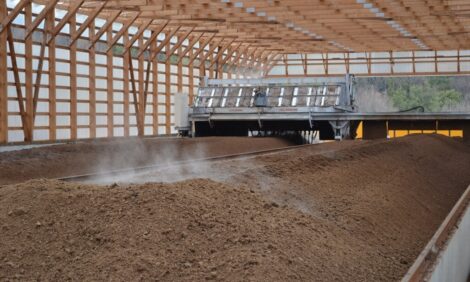



Performance Enhancement with Sodium Diformate in Broilers World-Wide: a New Approach for Poultry Production
Sodium diformate offers a new approach for broilers production worldwide, according to Christian Lückstädt and Sarah Mellor of Addcon.Evidence of the development of antibiotic resistant strains of bacteria that are pathogenic to humans has mounted over recent decades, and the practice of using sub-therapeutic levels of antibiotics as growth promoters (AGP) in livestock production has been heavily implicated in this resistance.
Worldwide, this connection has led to erosion of consumer trust in agricultural practices that rely on this valuable medical resource. Increasingly, legislation is limiting their use. The shift from AGP to alternatives begun in Europe rapidly spread, as exporting countries have had no choice but to comply.
A number of alternative feed additives have been investigated. Among the new, tested compounds are acidifiers. These supplements include organic acids and their salts, like diformates. Potassium diformate, for instance, the potassium double-salt of formic acid, rapidly gained formal approval as the first legal alternative for in-feed antibiotics in Europe.
Formic acid and its salts are well known to improve productivity, acting against pathogens, which decreases the pressure on the animal’s immune system. Thus, more nutrients will be available for productive functions such as growth or laying; whilst acting on the feed matrix to provide optimal conditions for digestive enzymes, particularly pepsin, releasing more nutrients from the feed. The double sodium salt of formic acid, while having the same antimicrobial properties as formic acid, has become more commonly used in poultry production, as it is easier to handle and does not negatively affect palatability, as can the pure acid.
Thus, several trials have been carried out in order to demonstrate the effectiveness of sodium diformate (Addcon) under various conditions worldwide.
A scientific trial with sodium diformate (NDF) was conducted at the research farm of the All-Russian Poultry Institute in Moscow, Russia. Each of the four groups, 0.1 per cent NDF, 0.3 per cent NDF and 0.5 per cent NDF, as well as a negative control, consisted of 35 one-day-old Cobb broilers, which were raised to 38 days on a commercial wheat-corn-soy diet.
Feed intake, growth, as well as mortality of birds were recorded. An economic analysis based on the European Broiler Index (EBI) was used to predict the benefit to the farmer. EBI is widely used to describe the efficiency of broiler production. It is calculated as:
EBI = Daily weight gain (g) × Survival ( per cent) / 10 × FCR
Statistical analysis was based on the Emperical Rule and µ±2σ was considered to be a significant result.
NDF addition was found to enhance individual live weights with increasing dosage, at day 26 as well as at the termination of the trial (day 38). By the end of the experiment, sodium diformate treatments improved broiler weight gain by 6.5 per cent to 10.3 per cent compared to the negative control. Based on the Empirical Rule all NDF treated groups differed statistically from the negative control (µ±3σ). NDF furthermore improved feed conversion ratio by 7.6 per cent (dosage: 0.1 per cent), 12.0 per cent (0.3 per cent) and 11.4 per cent (0.5 per cent) compared to the negative control group. The results are summarized in Table 1.
| Table 1. Dose-dependent performance of broiler fed with diformate | ||||
| Control | 0.1% NDF | 0.3% NDF | 0.5% NDF | |
|---|---|---|---|---|
| Weight, day 26 (g) | 904±15 | 1066±15 | 1079±19 | 1039±18 |
| Weight, day 38 (g) | 1872±20 | 1993±19 | 2044±24 | 2065±28 |
| FCR | 1.84 | 1.70 | 1.62 | 1.63 |
| Survival rate (%) | 94.3 | 100 | 100 | 100 |
| EBI | 247 | 302 | 325 | 327 |
These findings lead to the conclusion that addition of sodium diformate considerably improves poultry performance by increasing live weight and reducing feed consumption and thus feed conversion, compared to a negative control. The best results in respect of these parameters, calculated as a European Broiler Index (EBI), were obtained for the dosages of 0.3 per cent and 0.5 per cent NDF. The EBI for 0.3 per cent NDF inclusion improved by more than 31 per cent compared to the negative control group.
The benefits of incorporating sodium diformate in broiler diets were as well tested recently under tropical conditions in a trial conducted at the research farm of the University of Agriculture and Forestry in Ho Chi Minh City in Viet Nam. The acidifier was tested at two different dosages (0.1 per cent or 0.3 per cent NDF) in a commercial broiler diet, against the same diet containing either no acidifier (control group) or an antibiotic growth promoter (AGP: BMD-10 at 300g/t of feed). Feed and water were available ad libitum. The effects of NDF on performance parameters of poultry (livestock viability, live weight, feed consumption and feed conversion), on dressing (breast meat ratio), as well as litter quality (water content, bacterial load) were examined. 384 day old birds (Cobb 500) were randomly selected and divided into four treatment groups with 96 chicks each. The diets were fed for 42 days. Performance data were measured at the end of the trial (Table 2).
| Table 2. Performance, dressing and economic parameters in broiler fed with or without sodium diformate (NDF) | ||||
| Negative Control | NDF (1kg/t) | NDF (3kg/t) | AGP (300g/t) | |
|---|---|---|---|---|
| Number of birds | 96 | 96 | 96 | 96 |
| Final weight (kg) | 2.264 | 2.324 | 2.365 | 2.345 |
| Daily weight gain (g/d) | 52.8 | 54.2 | 55.2 | 54.7 |
| Daily feed intake (g/d) | 109.4 | 103.1 | 107.8 | 110.6 |
| FCR | 2.07 | 1.90 | 1.95 | 2.02 |
| Survival (%) | 95.8 | 97.9 | 97.8 | 99.0 |
| Breast ratio (%) | 22.7 | 23.9 | 24.0 | 23.3 |
| EBI | 244 | 279 | 277 | 268 |
| Cost of feed per 1kg gain* | 0.72 | 0.66 | 0.69 | 0.71 |
| *Calculated in US dollars | ||||
Overall performance in the groups with NDF was increased, even when compared to the AGP group. The addition of 0.1 per cent sodium diformate under the circumstances of the trial resulted in an increase of 2.6 per cent in weight gain, while the feed conversion rate was improved by 8.2 per cent, compared to the negative control. Furthermore, this NDF inclusion was best according to the broiler index as well as being the most cost effective. Furthermore, birds fed with NDF had a numerical improvement when dressed. The breast meat ratio increased by more than five per cent compared to the negative control, while the improvement compared the AGP group was still nearly three per cent. One could speculate that this was caused by the improved protein digestibility, which is often reported in conjunction with the use of dietary acidifier.

Finally, the faecal quality and content of birds was examined. It could be stated that the litter quality – based on the moisture content – was significantly (P<0.05) improved in birds fed NDF at both dosages (tested against the negative control). Moisture content in the faecal matter was reduced by either seven per cent (in the 0.1 per cent NDF-dosage) or five per cent (at 0.3 per cent inclusion of the additive); while the AGP-group had only a reduction of four per cent in the moisture content of faecal matter (moisture content of control litter was 57.2 per cent).
In conjunction with the improved quality of the litter is also the significantly reduced (P<0.05) level of E.coli in the faeces (Figure 1), which is measured as MPN (Most Probable Number). If looked at the reduction rate, one could say that the use of dietary sodium diformate reduces the E.coli load in faeces by 96 to 97 per cent!
Conclusion
Numerous reports have demonstrated how including sodium diformate in broiler diets has beneficial effects on performance by lowering bacterial pathogen load and improving nutrient digestibility. These benefits are turned into economic returns, despite the perceived increase in feed cost of using additives.
Further Reading
| - | Go to our previous news item on this story by clicking here. |
January 2012








